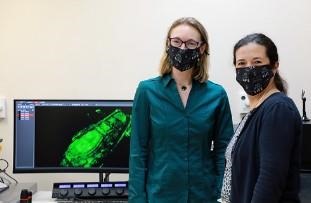By Robby Edwards
Microscopic images will now be sharper without distracting and distorting out-of-focus light for researchers, scientists and students in multiple academic disciplines in the Arkansas Agricultural Experiment Station and the University of Arkansas’ Dale Bumpers College of Agricultural, Food and Life Sciences.

SHARPER IMAGE — Fiona Goggin, left and Clemencia Rojas acquired a Leica Stellaris 8 confocal microscope, visible in the background, with a $481,121 USDA-NIFA grant. (U of A photo by Micayla Blair)
Fiona Goggin, professor, and Clemencia Rojas, assistant professor, both in the department of entomology and plant pathology, with a multidisciplinary team of researchers and teachers in other departments, received a $481,121 grant from the U.S. Department of Agriculture National Institute of Food and Agriculture. The NIFA award, together with $250,000 from the U of A Research and Innovation Office, allowed them to acquire a state-of-the art confocal microscope.
Goggin has a research appointment in the Agricultural Experiment Station, the research arm of the University of Arkansas System Division of Agriculture teaching appointment in Bumpers College. Rojas has teaching and research appointments in Bumpers College.
The other team members in the microscope grant all have dual appointments in the experiment station and Bumpers College:
- Alejandro Rojas and Martin Egan, assistant professors, department of entomology and plant pathology
- Vibha Srivastava and Mary Savin, professors, department of crop, soil and environmental sciences
- Jiangchao Zhao, associate professor, department of animal science
- Sami Dridi, department of poultry science
The advanced technology offers clearer images of cells, even when living.
“It allows us to visualize three-dimensional structures in cells with high resolution,” Rojas said. “We can image living cells and observe in real time all the dynamic processes that are occurring inside the cells.”
These images allow scientists to tell when and where important events occur when plants and animals encounter environmental stress or other organisms, such as microbes and insects. This information is important because the timing and location of immune responses can determine the difference between sickness and health for plants and animals.
Confocal microscopy offers several advantages over conventional widefield optical microscopy, including the ability to control the depth of field, to eliminate out-of-focus light, and to collect serial optical sections from thick specimens. These capabilities make it possible to construct three-dimensional images of specimens, including live samples, that are too thick for conventional microscopy.
“Confocal microscopy requires labeling molecules and subcellular structures with fluorescent dyes, and the lasers that are built in activate those fluorescent molecules, allowing us to see the cells,”Rojas said. “Some of us working with plant tissues face particular challenges due to a lot of autofluorescence in plants that overlap with the specs of most microscopes. This particular microscope is equipped with a white light laser that allows us to choose any possible combination of wavelengths to more precisely tune what we want to see and avoid the natural autofluorescence that tissues might have.”
The white light laser, as well as advanced, highly sensitive detector systems, make this microscope, a Leica Stellaris 8, the most advanced confocal microscope on campus and in the state. The microscope is part of a fee-based core facility accessible by research groups at the U of A and the Arkansas Agricultural Experiment Station, the research arm of the U of A System Division of Agriculture.
“The microscope will be used by a multidisciplinary team of scientists from multiple departments to study stress physiology and the impacts of microbial communities on plants, animals and soil ecosystems,” Goggin said. “The ultimate goal of this work is to develop strategies to protect the health and productivity of crops, livestock and agricultural lands.”
Source : uada.edu